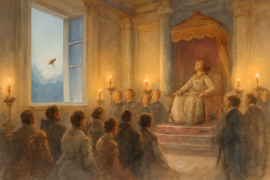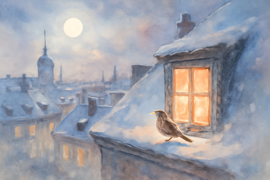Introduction
In the heart of old Copenhagen, where cobblestone alleys wound like whispered secrets beneath gaslit lamps, a humble nightingale arrived under a moon veiled by drifting clouds. Word spread from fishermen on Nyhavn’s quays to the watchful guards atop Rosenborg Castle: a bird of astonishing beauty had come to lend its melody to the kingdom’s quiet nights. The emperor, burdened by sorrow since losing his beloved queen, had sealed his heart behind gilded doors, vowing never to smile again. But on a night when the world seemed suspended between winter’s chill and the promise of spring, the court’s sentinel caught the soft warble drifting through palace windows. It was as if each note unburdened a sigh the stars had held for centuries. In a kingdom grown cold with grief, the nightingale’s song stirred hope anew, weaving magic through the streets and awakening the forgotten grace hidden in every living soul.
Moonlit Melody
When the emperor summoned the mysterious singer into his grand hall, even the polished floors seemed to hush in anticipation. Rich tapestries draped the walls, but no woven thread matched the golden luster of each note. As the nightingale alighted on a velvet cushion beneath towering pillars of marble, courtiers leaned forward, their anxious whispers stilling at the first trill. The emperor, clad in an ermine-lined cloak and crowned by sorrow, pressed trembling fingers to his heart. The bird’s song—tender, quivering, yet unwavering—wove through every soul present, carrying memories of laughter, of dawn’s first light, and the warmth of arms long gone.

Though trained musicians waited with lutes, harps, and violins poised, they dared not break the spell. It was more than music; it was the language of life itself. When the nightingale paused, expecting applause, the emperor spoke instead. He confessed his burden, his fear that joy had abandoned his palace forever. With gentle eyes, the tiny creature opened its beak once more, pouring hope into the still air until tears glimmered on the emperor’s cheeks like dew.
In the weeks that followed, courtiers begged the bird for daily concerts. Each morning, citizens gathered along palace balconies, longing for the delicate arias that banished melancholy. Yet with every performance, the nightingale weakened; it fed on wild berries and clear water, but the grandeur of marble halls left it longing for open forests and moonlit birch groves. Concern spread: their gift had become the bird’s burden.
Eager to preserve the miracle, the imperial engineer unveiled a mechanical marvel—a gilded contraption of moving flutes and polished brass feathers. When it sprang to life, its melody echoed with clockwork precision. The court celebrated: no creature would suffer for the emperor’s delight. But as the machine’s song unfurled, an eerie hollow resonance filled the hall. The notes were perfect in form but void of soul. Courtiers exchanged uneasy glances; the wind outside had grown still, as though nature itself refused to witness the imitation.
Late that night, the emperor wandered the gardens, drawn by a single, faltering note. There, among moonlit roses, he found the real nightingale—weak but resolute—singing to a world that desperately needed its living voice. Kneeling in the soft grass, he gently cupped the bird in his hands and whispered gratitude. He recognized that beauty could not be chased or replicated; it had to be honored and set free.
The next dawn, the emperor stood before his court and offered a decree: the mechanical bird was to be dismantled, its parts returned to the earth. The nightingale would perform only when free to choose. From that moment on, whenever sorrow darkened the kingdom’s gates, citizens would follow its song into the forests, where they learned to listen to every rustling leaf and babbling brook.
Generations passed, and the nightingale became a symbol of true, unforced joy. In winter’s hush and summer’s bloom, its melody reminded all of the fragile beauty that thrives in freedom and simplicity. And in the hush between heartbeats, they heard an echo of that moonlit night when one small bird restored the spirit of a grieving empire.
Conclusion
Long after the marble pillars crumbled and the palace gates rusted to neglect, the nightingale’s legend endured among villagers and wandering minstrels. They spoke of a time when a fragile bird dared to sing before an emperor, reminding a kingdom that true beauty springs from the unbridled heart. In honoring that song, they learned that life’s most precious gifts cannot be manufactured or caged—they must be cherished, shared, and set free under moonlit skies, wherever hope is found in a simple melody.



















